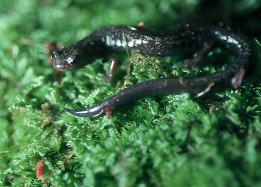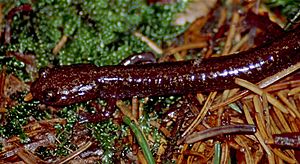Cheat Mountain salamander facts for kids
Quick facts for kids Cheat Mountain salamander |
|
|---|---|
 |
|
| Conservation status | |
| Scientific classification | |
| Genus: |
Plethodon
|
| Species: |
nettingi
|
The Cheat Mountain salamander (Plethodon nettingi) is a small, dark salamander that lives only in the high mountains of West Virginia. You can find it on Cheat Mountain and a few other mountains nearby. It's special because it's one of only two animal species with a backbone (vertebrates) that are found nowhere else in the world except West Virginia! The other is the West Virginia spring salamander.
Sadly, the number of Cheat Mountain salamanders has gone down. This is mostly because their home, the red spruce forests, has been damaged or destroyed. Other problems like pollution, dry weather (droughts), and storms also hurt them. They also have to compete for food and space with other salamanders, especially their cousin, the red-backed salamander.
Contents
What Does It Look Like?
The Cheat Mountain salamander is a small creature, about the same size as the red-backed salamander. It grows to be about 3 to 4.75 inches (7.5 to 12 centimeters) long. Its back is black or dark brown and has many tiny, shiny flecks that look like brass, silver, or white. It doesn't have a stripe down its back. Its belly is dark gray to black. Its tail is about the same length as its body. Along its sides, it has 17 to 19 vertical grooves called costal grooves.
How Was It Discovered?
This unique salamander was first found by M. Graham Netting and Leonard Llewellyn in 1935. They discovered it on White Top, a high point on Cheat Mountain in Randolph County. Later, in 1938, a scientist named N. Bayard Green officially described and named the species.
For a while, the Cheat Mountain salamander and another salamander called the Peaks of Otter salamander were thought to be the same species, just different types. But since 1979, scientists have decided they are completely separate species. It's believed that in the past, these salamanders lived in much larger areas.
Where Does It Live?
The Cheat Mountain salamander lives in a small part of the high Allegheny Mountains in eastern West Virginia. When it was first found in the 1930s and 1940s, people thought it only lived on Cheat Mountain. It was found at high places, usually above 3,500 feet (1,067 meters) in Randolph County and Pocahontas County.
Later studies in the 1970s and 1980s showed that its home range was bigger. It was also found in Pendleton and Tucker Counties. More recently, it has been found in the eastern part of Grant County, even as low as 2,640 feet (805 meters). Most groups of these salamanders still live above 3,500 feet.
The total area where the Cheat Mountain salamander lives is about 935 square miles (2,422 square kilometers). However, they don't live everywhere in this area. There are about 60 separate groups of them. A lot of their home is inside the Monongahela National Forest.
What Kind of Home Does It Like?
Originally, the Cheat Mountain salamander probably lived only in red spruce forests in West Virginia's tall mountains. Most of these forests were cut down by 1920. So, today, many salamander groups live in mixed forests that grew back where the red spruce used to be. These new forests have trees like yellow birch, American beech, sugar maple, striped maple, and eastern hemlock.
The salamander doesn't need a specific type of plant to live. Instead, it often lives near big rocks, rocky areas, or shady, steep valleys with lots of rhododendron plants. They are more common near large rocks because the soil and leaves there stay more moist and cooler than other areas. It's possible these rocky spots helped them survive when the original forests were cut down and sometimes burned. They are usually found where the ground is covered with mosses and liverworts, and lots of fallen leaves, logs, and sticks.
What Does It Eat?
Like other woodland salamanders, the Cheat Mountain salamander eats small creatures. Its diet includes mites, springtails, beetles, flies, and ants. On damp evenings, it searches the forest floor, rocks, and logs for its next meal. Sometimes, it will even climb trees, shrubs, and stumps to find food.
How Does It Behave and Reproduce?
Cheat Mountain salamanders spend the winter months underground. This keeps them safe from freezing temperatures. They usually come out from their underground hiding spots in late March or early April. They go back underground in mid-October. When they are above ground, they are most active at night, especially when the weather is humid. During the day, they hide under rocks, or inside and under logs. Sometimes, they hide among wet leaves. They only hide away for long periods during very dry conditions.
Scientists haven't directly seen Cheat Mountain salamanders breeding. But it most likely happens on the forest floor. Male and female pairs have been found together under rocks in both spring and autumn. During these times, both sexes are ready to breed. Males have swollen areas and squared-off snouts, and females have eggs ready to develop.
Their nesting habits are similar to the red-backed salamander. The female usually lays 8 to 10 eggs, but sometimes as few as 4 or as many as 17. She attaches the eggs to the inside of a rotten log or the underside of a rock or log. This can happen in both red spruce or other types of forests. Females guarding small groups of eggs have been found from late April through early September. The female stays with the eggs and protects them until they hatch. This behavior is special to salamanders in the woodland salamander family, called Plethodontidae. The young salamanders develop completely inside the egg. So, when they hatch in late August or September, they look like tiny adults.
Young Cheat Mountain salamanders become old enough to breed in 3 to 4 years. They can live for about 20 years! The young might stay near the adult salamanders until they are mature. Then, they move away to find their own areas. Each salamander's territory is about 48 square feet (4.5 square meters). Woodland salamanders usually don't leave their territories. This means they only move a few meters during their entire lives.
How Are We Protecting Them?
The number of Cheat Mountain salamanders probably dropped sharply when their original home, the red spruce forests, was destroyed by logging in the early 1900s. Because of this, the Cheat Mountain salamander is now on the U.S. Endangered Species List. This means it's protected by the Federal Endangered Species Act as a threatened species since 1989.
Any changes that expose the forest floor to sunlight can harm these salamanders. They need cool, moist conditions for their nests, food, and even to breathe. Even small changes, like clearing paths for service roads or hiking trails, can split up groups of salamanders. This is because these salamanders won't cross bare ground. When groups are separated, they become weaker and less likely to survive. These changes also make it easier for other salamanders, like the mountain dusky and red-backed salamanders, to move in. These other salamanders then compete with the Cheat Mountain salamander for food, hiding spots, and moisture.
Luckily, a large part of the Cheat Mountain salamander's home (46 out of 60 known groups) is within the Monongahela National Forest. A plan was created to help them recover by the U.S. Fish and Wildlife Service (USFWS). Each year, surveys are done by Thomas Pauley, a scientist who knows a lot about this species. He says that their numbers seem to be steady, except in places where their homes have been changed. The West Virginia Division of Natural Resources also checks on their populations. Since both the salamander and its home are watched over and protected in the National Forest and the Canaan Valley National Wildlife Refuge, its future looks hopeful.
Images for kids




